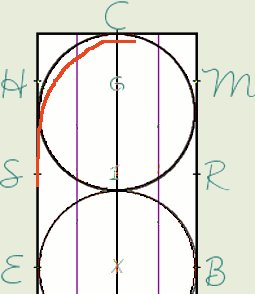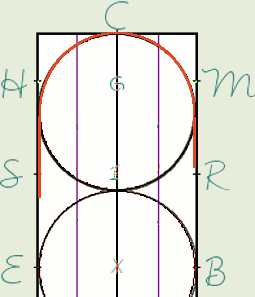Canter Serpentine, no change of lead
making
it easy
A really nice thing about the canter serpentine, no change of
lead, happens just after the second loop, when the horse
finishes half of the 20m circle in counter canter and
crosses the center line to resume true canter for the last half
20m circle. It's an 'a ha!' moment where they gather
themselves mentally and physically. They move
straighter and it's like they stand a little taller for
having worked something out successfully. It's where
the beauty of the movement resides.
really nice thing about the canter serpentine, no change of
lead, happens just after the second loop, when the horse
finishes half of the 20m circle in counter canter and
crosses the center line to resume true canter for the last half
20m circle. It's an 'a ha!' moment where they gather
themselves mentally and physically. They move
straighter and it's like they stand a little taller for
having worked something out successfully. It's where
the beauty of the movement resides.
The goal for this week was to get three of my girls
accomplished at this - beyond the once off successful run
to a more relaxed, coherent beneficial suppling and straightening
exercise.
As well as occasionally blasting through canter
serpentines, I've also got a few other skills at the
ready. Since I like to start from the walk, I
have my walk-canter transition pretty well confirmed.
I also have the canter lead pretty well confirmed.
And I've already played at simple changes and flying
changes as well as 'counter-canter' along the long
wall. So these are skills that the horses already
have in their memory banks.
Since my goal is to add this to my 'confirmed' set of
skills, I began by figuring out the building blocks
necessary - what's the easiest thing? In this case I
figured a half 20m circle on the short wall - supported by
the sides of the arena, would be easier
than a half 20m circle in the middle of the ring, with no
walls for psychological help, and the
end point for that is to 'counter canter' down the long
wall. That, then, became the starting point.
By establishing the end of the movement as the the
starting point and confirming that skill first, the horse
comes to know where the finish is. This is a
psychological strategy to calm them. If we were to
begin with the first aspect and keeping adding to it, the
skill would seem progressively harder and longer -- with
maybe no end in sight! If, however, we teach the tail
end first, they are always arriving at and ending on
something they already know. This is calming to the
lizard brain. They know they're finished, all the
hard stuff is done.
And I say 'counter canter' because, really, I don't think
the horse has a preference here. To them, it's
just a canter. Unless of course they've been taught
otherwise. Which, as it turns out, was the case for
one of my horses.
ACK!
The first day was spent reassuring her that the earth
would not open and the skies would not fall if she were to
canter down the long wall on the 'opposite' lead.
Eventually I could aim her from say P to X and then veer
sideways towards S and if I was careful not to get too
close to the wall, keep the 'counter canter.' Too
close and I'd get a flying change and a hissy fit.
But eventually I could get maybe a quarter ways down the
long wall in the 'counter canter' if I stayed on the
quarter line. Oi weh. Then maybe sneak a little
closer to the wall...
Next day, much better! And we could proceed
with where the others had started, which was counter-canter
around the short end of the arena.
| Note: This example and these
diagrams are for the right lead canter while
tracking left. In reality, all four corners
are used in similar fashion. |
As mentioned, the tail end of counter canter through
the short end means coming out of the corner on the
opposite lead -- so in this case with right lead canter at
H while tracking left. (Fig. A)
For this I would walk from C to H on the 20m circle,
preparing a few steps ahead, and ask for my right lead
canter as I came to the long wall. Sometimes I could
simply ask for the right lead canter and other times it
helped to aim towards the other side of the arena, pick up
the right lead and then come back to the track. A
sort of 'tricked you!' kind of smaller version of what I'd
done for my concerned horse.
After about four goes of that in both directions, I
asked for the right lead canter a few steps earlier - both
directions four times, and then at C and angled it in
towards the side of the circle (Fig. B) asking to come a
little closer to a circular shape as the horses were able
to accommodate that. Eventually I asked before
C and then would ask coming into the short end. (Fig.
C) So I was asking for more and more steps of canter
on the opposite lead, always ending with the few steps of
'counter canter' they were familiar with heading towards E.
| Example of building up
the right lead canter while tracking left. |
 |
 |
 |
| Fig. A |
Fig. B |
Fig. C |
When this was working relatively well it was simple
enough to would reposition myself for the three loop
serpentine and sandwich the counter canter between the two
half 20m canter circles.
Breaking the three loop serpentine down into smaller
chunks and progressing by beginning at the end and backing
up to the start allowed the horses to develop their sense
of accomplishment and add this exercise to my list of
'confirmed' skills.
If you try it, let me know how it goes! And if
you'd like some hands on, call me up for a
lesson.
Cheers!
L
|




![Centered Riding Today: An Informal Talk by Sally Swift [VHS]](http://ecx.images-amazon.com/images/I/41Vn6PfhzML._SL125_.jpg)
![Centered Riding with Sally Swift [VHS]](http://ecx.images-amazon.com/images/I/51OSh9kd9iL._SL125_.jpg)
 really nice thing about the canter serpentine, no change of
lead, happens just after the second loop, when the horse
finishes half of the 20m circle in counter canter and
crosses the center line to resume true canter for the last half
20m circle. It's an 'a ha!' moment where they gather
themselves mentally and physically. They move
straighter and it's like they stand a little taller for
having worked something out successfully. It's where
the beauty of the movement resides.
really nice thing about the canter serpentine, no change of
lead, happens just after the second loop, when the horse
finishes half of the 20m circle in counter canter and
crosses the center line to resume true canter for the last half
20m circle. It's an 'a ha!' moment where they gather
themselves mentally and physically. They move
straighter and it's like they stand a little taller for
having worked something out successfully. It's where
the beauty of the movement resides.





